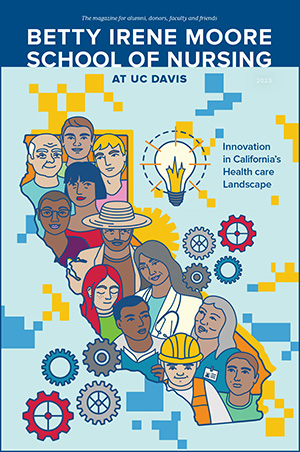Equity in health starts with fresh look at assumptions
Access to health care is not equal.
Furthermore, attainment of health is not equitable. Health inequities stem from systemic and structural inequities that run deep in the fabric of our society.
Faculty and curriculum at the Betty Irene Moore School of Nursing at UC Davis actively works to change that narrative and develop meaningful solutions.
According to the authors of the journal article, “Social justice in health system; a neglected component of academic nursing education: a qualitative study,” “increasing social and health inequalities all over the world have highlighted the importance of social justice as a core nursing value. Accordingly, it is necessary to modify the content of nursing curriculum and education approaches in order to convey this core value.”
“Schools of nursing, over time, have embraced the notion of cultural competence — our ability to care for people who are different from us in some way. It has turned into this metric where we try to define and quantify what competence looks like,” explained Kupiri Ackerman-Barger, associate dean for Health Equity, Diversity and Inclusion. “But in that process, we have created stereotypes where we have test questions or textbooks that say, ‘this is what African-American people do; this is what Muslim people do; this is what Chinese people do.’ That becomes a really reductionist way of looking at individuals.”
Ackerman-Barger admits the textbooks are not there yet. In fact, hindsight on cultural competence principles points to stereotyping. That’s why, she says, we must focus on cultural humility — a lifelong process of self-reflection and self-critique whereby the individual not only learns about another’s culture, but one starts with an examination of her or his own beliefs and cultural identities.
Humility serves as a cornerstone of diversity and inclusion, a core value at the School of Nursing. It is also integrated across the three-year curriculum of the new Doctor of Nursing Practice — Family Nurse Practitioner (DNP-FNP) Degree Program.
“We look at health disparities and social determinants and examine health equity from historical and societal perspectives,” said Kathryn Sexson, DNP-FNP program director. “We then educate our students so that they actually have a framework of cultural humility to start to break down barriers that contribute to inequities for marginalized and underserved populations.”
One area of the hybrid program, which combines distanced-based education with four on-campus immersions, that captures Sexson’s full attention is the evidence-based practice course. Many practitioners find their ‘practice pearls’ in the discussion section of published research, rather than interpreting the data independently. Sexson warns that could inadvertently create a health inequity.
“Take, for example, whether or not ACE inhibitors are protective of COVID-19. A recent articled concluded yes. However, when you start dissecting the data, COVID-19 rates actually go up for African American and Asian people who are on an ACE inhibitor,” Sexson explained. “We want to use evidence to support health equity.”
In addition to looking at the data through the lens of health disparities, changing outcomes can only result from the diversity of perspectives in the mix.
“What we need is the power of diverse and representative thinkers that can help us think about the solutions that we need to implement, so that we see more equitable health outcomes across communities, neighborhoods and populations,” Ackerman-Barger said. “We also need to make sure that there is equity in access to becoming a health care provider or to becoming doctorally prepared.”
The School of Nursing was founded to affirm the voices and perspectives of people from diverse backgrounds and experiences. In all graduate degree programs, diverse students are recruited and included to achieve health and health care equity.
“We are helping them learn how to start integrating knowledge and challenging what they think to be true,” Sexson added. “They have this great potential. We want to give them the foundation to achieve it and carry them the next 25 or 30 years of their practice.”





